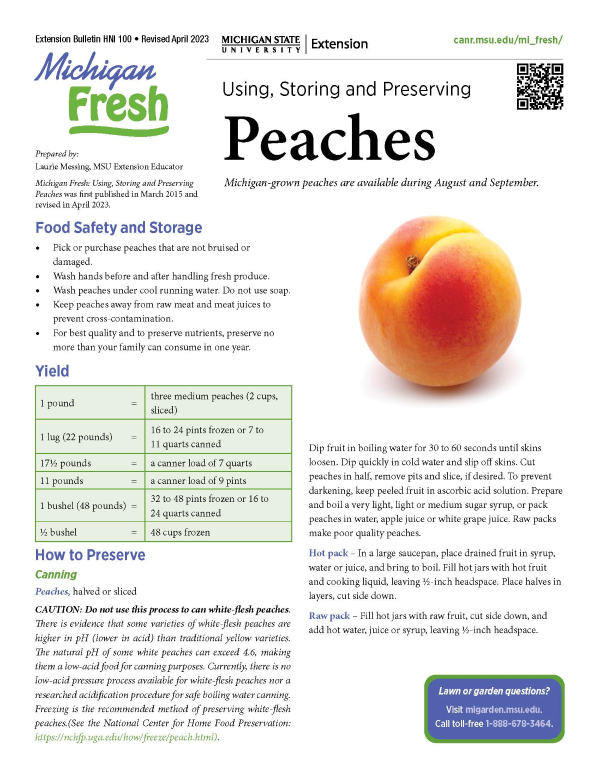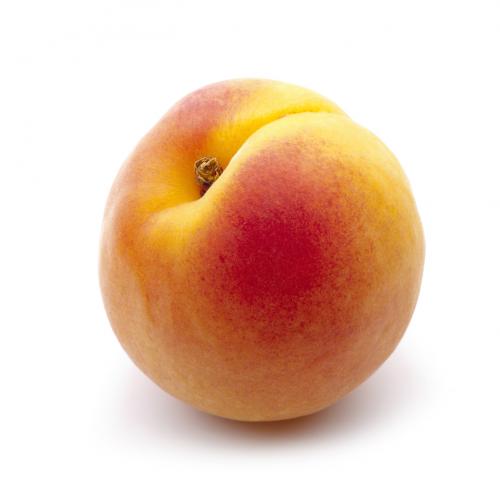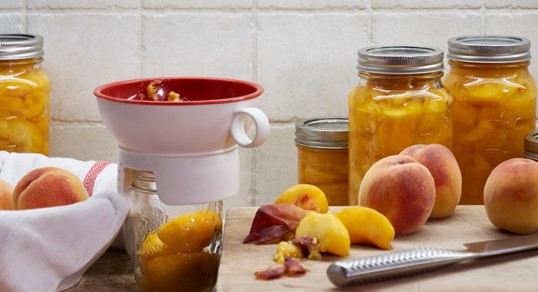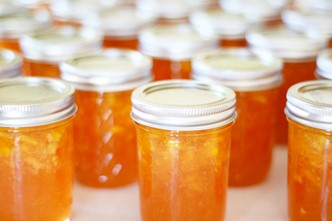
Michigan Fresh: Using, Storing, and Preserving Peaches (HNI100)
DOWNLOADJuly 17, 2023 - Laurie Messing, Michigan State University Extension
This Document is offered in: English, Arabic Espanol,
Food Safety and Storage

- Pick or purchase peaches that are not bruised or damaged.
- Wash hands before and after handling fresh produce.
- Wash peaches under cool running Do not use soap.
- Keep peaches away from raw meat and meat juices to prevent cross-contamination.
- For best quality and to preserve nutrients, preserve no more than your family can consume in one year.
Yield
|
1 pound = |
three medium peaches (2 cups, sliced) |
|
1 lug (22 pounds) = |
16 to 24 pints frozen or 7 to 11 quarts canned |
|
17½ pounds = |
a canner load of 7 quarts |
|
11 pounds = |
a canner load o f 9 pints |
|
1 bushel (48 pounds) = |
32 to 48 pints frozen or 16 to 24 quarts canned |
|
½ bushel = |
48 cups frozen |
How to Preserve
Canning
Peaches, halved or sliced
CAUTION: Do not use this process to can white-flesh peaches. There is evidence that some varieties of white-flesh peaches are higher in pH (lower in acid) than traditional yellow varieties. The natural pH of some white peaches can exceed 4.6, making them a low-acid food for canning purposes. Currently, there is no low-acid pressure process available for white-flesh peaches nor a researched acidification procedure for safe boiling water canning. Freezing is the recommended method of preserving white-flesh peaches.(See the National Center for Home Food Preservation: https://nchfp.uga.edu/how/freeze/peach.html).
Dip fruit in boiling water for 30 to 60 seconds until skins loosen. Dip quickly in cold water and slip off skins. Cut peaches in half, remove pits and slice, if desired. To prevent darkening, keep peeled fruit in ascorbic acid solution. Prepare and boil a very light, light or medium sugar syrup, or pack peaches in water, apple juice or white grape juice. Raw packs make poor quality peaches.
Hot pack – In a large saucepan, place drained fruit in syrup, water or juice, and bring to boil. Fill hot jars with hot fruit and cooking liquid, leaving ½-inch headspace. Place halves in layers, cut side down.
Raw pack – Fill hot jars with raw fruit, cut side down, and add hot water, juice or syrup, leaving ½-inch headspace.
Remove air bubbles, adjust headspace if needed, wipe jar rims with clean paper towel, adjust lids and process following directions below:
|
Recommended process time for peaches (in minutes), halved or sliced, in a boiling-water canner. |
|||||
| Process time (in minutes at altitudes of | |||||
| Style of Pack | Jar Size | 0-1,000 ft. | 1,001-3,000 ft. | 3,001-6,000 ft. | Above 6,000 ft. |
| Hot | Pints | 20 | 25 | 30 | 35 |
| Quarts | 25 | 30 | 35 | 40 | |
Raw |
Pints | 25 | 30 | 35 | 40 |
| Quarts | 30 | 35 | 40 | 45 | |
|
Recommended process times for peaches (in minutes), halved or sliced, in a dial-gauge pressure canner. |
||||||
| Canner pressure (PSI) at altitudes of | ||||||
| Style of pack | Jar Size | Process Time (min.) | 0-2,000 ft. | 2,001-4,000 ft. | 4,001-6,000 ft. | 6,001-8,000 ft. |
| Hot and raw | Pints or Quarts | 10 | 6 | 7 | 8 | 9 |
|
Recommended process times for peaches (in minutes), halved or sliced, in a weighted-gauge pressure canner. |
||||
| Canner pressure (PSI) at altitudes of | ||||
| Style of pack | Jar size | Process time (min.) | 0-1,000 ft. | Above 1,000 ft. |
| Hot and raw | Pints or quarts | 10 | 5 | 10 |
Let jars stand undisturbed on the counter for 12 to 24 hours, remove rings, check to make sure lids are sealed, wash jars, label, date and store.

| Preparing and Using Syrups | ||||||
|
|
Measures of water and sugar |
|
||||
|
Syrup type |
Approx. % sugar |
For 9-pt load (1) |
For 7-qt load |
Fruits commonly packed in syrup (2) |
||
|
|
|
Cups water |
Cups sugar |
Cups water |
Cups sugar |
|
|
Very light |
10 |
6½ |
¾ |
10½ |
1¼ |
Approximates natural sugar levels in most fruits and adds the fewest calories. |
|
Light |
20 |
5¾ |
1½ |
9 |
2¼ |
Very sweet fruit. Try a small amount the first time to see if your family likes it. |
|
Medium |
30 |
5¼ |
2¼ |
8¼ |
3¾ |
Sweet apples, sweet cherries, berries, grapes. |
|
Heavy |
40 |
5 |
3¼ |
7¾ |
5¼ |
Tart apples, apricots, sour cherries, gooseberries, nectarines, peaches, pears, plums. |
|
Very heavy |
50 |
4¼ |
4¼ |
6½ |
6¾ |
Very sour fruit. Try a small amount the first time to see if your family likes it. |
- This amount is also adequate for a 4-quart
- Many fruits that are typically packed in heavy syrup are excellent and tasteful products when packed in lighter The USDA recommends that lighter syrups be tried, since they contain fewer calories from added sugar.
This table is adapted from “Table 1. Preparing and Using Syrups” from Selecting, Preparing and Canning Fruit on the National Center for Home Food Preservation website at https://nchfp.uga.edu/how/can_02/syrups.html. That table was adapted from the USDA’s Complete Guide to Home Can- ning (Agriculture Information Bulletin No. 539). Revised 2015.
Freezing
Select well-ripened fruit and handle carefully to avoid bruising. Sort, wash and peel.
Syrup pack – Use 40 percent syrup. For a better quality product, add ½ teaspoon (1500 mg) ascorbic acid per quart of syrup. Put peaches directly into cold syrup in container, starting with ½ cup syrup to a pint container. Press fruit down and add syrup to cover, leaving ½- to 1½-inch headspace dependent on container type. Place a small piece of crumpled water-resistant paper on top to hold fruit down. Seal, label, date and freeze.
Sugar pack – To each quart (1⅓ pounds) of prepared fruit, add ⅔ cup sugar and mix well. Stir gently until sugar is dissolved or let stand for 15 minutes. To lessen darkening, sprinkle ascorbic acid dissolved in water over the peaches before adding sugar. Use ¼ teaspoon (750 mg) ascorbic acid in 3 tablespoons cold water for each quart of fruit. Pack into containers, leaving ½- to 1½-inch headspace dependent on container type. Seal, label, date and freeze.
Crushed or purée – Coarsely crush peeled and pitted peaches. For purée, press through a sieve or purée in a blender or food processor. (Heating pitted peaches for 4 minutes in just enough water to prevent scorching makes them easier to purée.) For better quality, add ⅛ teaspoon (375 mg) ascorbic acid to each quart of fruit. Pack into containers. Leave ½- to 1½-inch headspace dependent on container type. Seal, label, date and freeze.
|
Syrups for Use in Freezing |
||||
|
Type of syrup |
Percent syrup* |
Cups of sugar** |
Cups of water |
Yield of syrup (cups) |
|
Very light |
10% |
½ |
4 |
4½ cups |
|
Light |
20% |
1 |
4 |
4¾cups |
|
Medium |
30% |
1¾ |
4 |
5 cups |
|
Heavy |
40% |
2¾ |
4 |
5⅓ cups |
|
Very heavy |
50% |
4 |
4 |
6 cups |
*Approximate
**In general, up to one-fourth of the sugar may be replaced by corn syrup or mild-flavored honey. A larger proportion of corn syrup may be used if a very bland, light-colored type is selected.
Peach Jam (With Powdered Pectin) 
- 3¾ cups crushed peaches (about 3 pounds peaches)
- ¼ cup lemon juice
- 1 package powdered pectin
- 5 cups sugar
Yield: About 6 half-pint jars
Sterilize canning jars and prepare two-piece canning lids according to manufacturer’s directions.
To prepare fruit, sort and wash fully ripe peaches. Remove stems, skins, and pits. Crush peaches.
To make jam. Measure crushed peaches into a kettle. Add lemon juice and pectin; stir well. Place on high heat and, stirring constantly, bring quickly to a full boil with bubbles over the entire surface. Add sugar, continue stirring, and heat again to full bubbling boil. Boil hard for 1 minute, stirring constantly. Remove from heat; skim.
Fill hot jam immediately into hot, sterile jars, leaving ¼-inch headspace. Wipe rims of jars with a clean paper towel; adjust two-piece metal canning lids. Process half-pint or pints in a boiling water canner for 5 minutes (for elevation under 1,000 feet).
“Peach Jam (With Powdered Pectin)” recipe is adapted from the National Center for Home Food Preservation recipe of the same name at https://nchfp.uga.edu/how/can_07/peach_ jam_powder.html. That recipe was adapted from “How to Make Jellies, Jams and Preserves at Home.” Home and Garden Bulletin No. 56. Extension Service, United States Department of Agriculture. 1982 reprint. National Center for Home Food Preservation, June 2005.
References
-
Andress, E., & Harrison, J. A. (2014). So easy to preserve (Bulletin 989). (6th ed.). University of Georgia Cooperative Extension.
-
Complete guide to home canning. (2015). United States Department of Agriculture.
-
National Center for Home Food Preservation. http://nchfp.uga.edu/
More information



 Print
Print Email
Email





